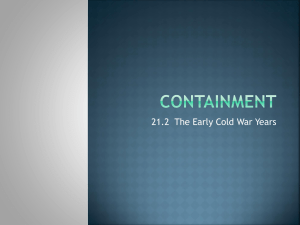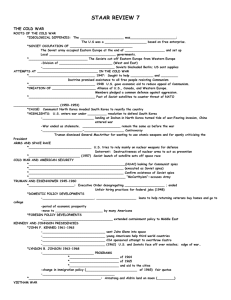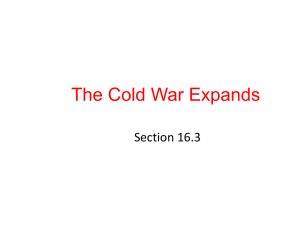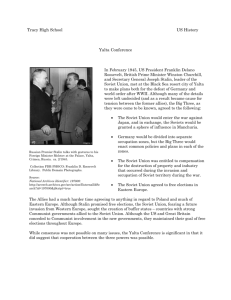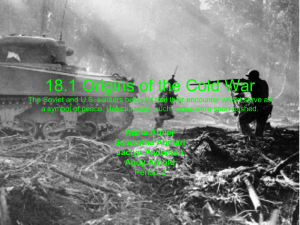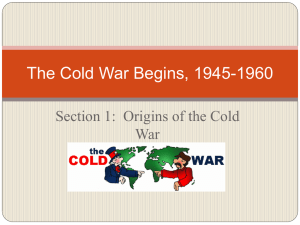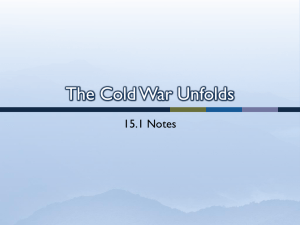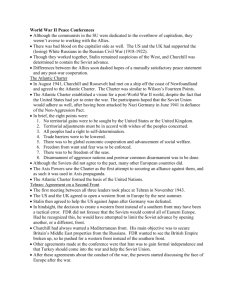Stalin's aims in Europe after the war
advertisement
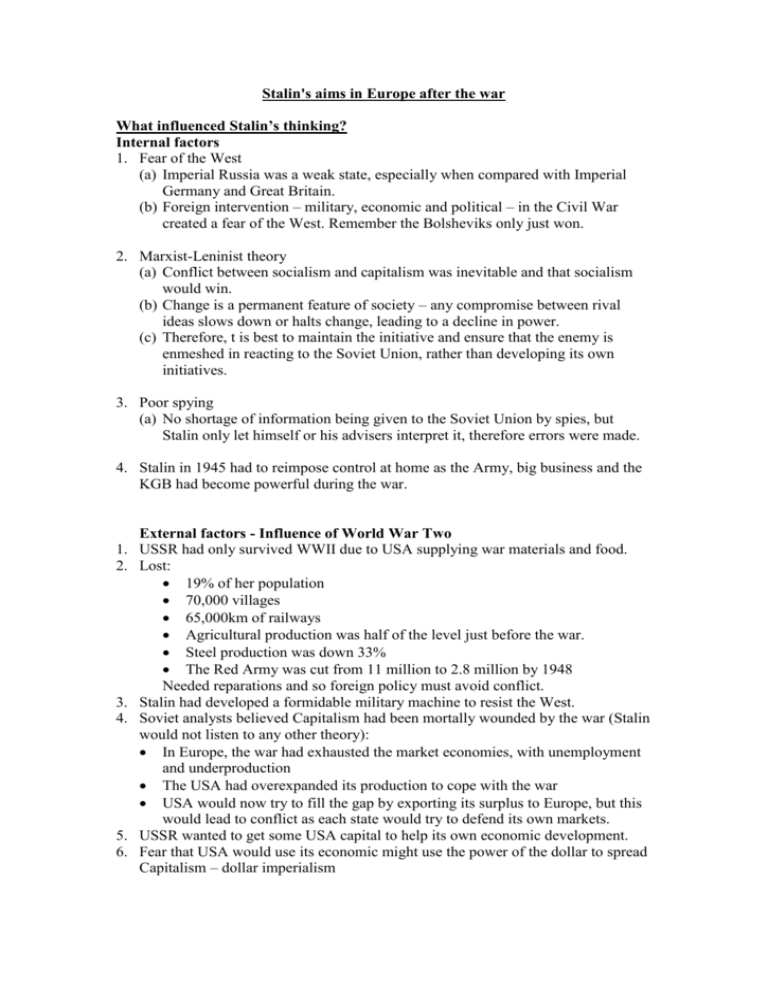
Stalin's aims in Europe after the war What influenced Stalin’s thinking? Internal factors 1. Fear of the West (a) Imperial Russia was a weak state, especially when compared with Imperial Germany and Great Britain. (b) Foreign intervention – military, economic and political – in the Civil War created a fear of the West. Remember the Bolsheviks only just won. 2. Marxist-Leninist theory (a) Conflict between socialism and capitalism was inevitable and that socialism would win. (b) Change is a permanent feature of society – any compromise between rival ideas slows down or halts change, leading to a decline in power. (c) Therefore, t is best to maintain the initiative and ensure that the enemy is enmeshed in reacting to the Soviet Union, rather than developing its own initiatives. 3. Poor spying (a) No shortage of information being given to the Soviet Union by spies, but Stalin only let himself or his advisers interpret it, therefore errors were made. 4. Stalin in 1945 had to reimpose control at home as the Army, big business and the KGB had become powerful during the war. 1. 2. 3. 4. 5. 6. External factors - Influence of World War Two USSR had only survived WWII due to USA supplying war materials and food. Lost: 19% of her population 70,000 villages 65,000km of railways Agricultural production was half of the level just before the war. Steel production was down 33% The Red Army was cut from 11 million to 2.8 million by 1948 Needed reparations and so foreign policy must avoid conflict. Stalin had developed a formidable military machine to resist the West. Soviet analysts believed Capitalism had been mortally wounded by the war (Stalin would not listen to any other theory): In Europe, the war had exhausted the market economies, with unemployment and underproduction The USA had overexpanded its production to cope with the war USA would now try to fill the gap by exporting its surplus to Europe, but this would lead to conflict as each state would try to defend its own markets. USSR wanted to get some USA capital to help its own economic development. Fear that USA would use its economic might use the power of the dollar to spread Capitalism – dollar imperialism What policies emerged as a result of these influences on Stalin? 1. All resources and forces were to be mobilised to halt and turn back the spread of American Capitalism. 2. Soviet strengths, such as the Red Army and control of Communist parties in Europe, were to be used to defend Soviet security and expand Soviet influence. 3. Great care to avoid provoking the USA. Of these policies, Soviet security seemed to be the key feature. Why was Stalin in a better position than before the war? 1. The war had made Stalin into “Uncle Joe” 2. Moscow appealed to all peace-loving nations to unite under a new type of democracy. BUT the Soviets had no clear idea where this new democracy would lead. How did Stalin begin to implement his new policies? 1. Communist parties no longer spoke of spreading “revolution” 2. The emphasis was on co-operation with the Allies. (a) In East and South-East Europe, every effort was to be made to secure a decisive role in the government for the Communist Party to ensure permanent pro-Soviet support there. (b) In West and South Europe, try to stabilise the situation, to stop the spread of Capitalism (c) In Germany and Austria – cooperate with the Allies and win the support of the people, so that when the Soviets withdrew, countries would not just turn to Capitalism. (d) In Germany they tried to stop Germany following anti-Soviet foreign policy and ensure that Germany’s economic potential did not serve the USA. How the Cold War developed 1946 Moscow Conference, December 1945 - the last sign of good relations? 1. The three foreign ministers of Britain the Soviet Union and USA met and ensured there would be: non-Communist representation in the governments of Bulgaria and Rumania; a meeting of the Council of Foreign Ministers in Spring 1946 to discuss peace treaties with Germany's former allies; a chance for each of the allies to say how Japan should be run after the war. 2. These agreements were cosmetic as: the Soviets were recognised as controlling Eastern Europe; the Americans were recognised as controlling Japan. 3. However there were still some good relations: Truman wanted to keep on talking to try to secure a deal with the Soviets. Stalin was willing to have a façade of Allied help in the East. What was the situation in the world? 1. Europe was in a critical state with hunger, disease, refugees, the need to move to a peacetime economy, falls in output, unemployment, debt. 2. The British economy was weak. 3. The USA was now the world's leading power. 4. The USSR had expanded into eastern and south-eastern Europe. 5. This left western and southern Europe with a power vacuum. The "Long Telegram" and the changing mood in America 1. They were turning anti-Soviet There were criticisms of the Foreign Secretary, Byrnes, saying that he was too lenient towards the Soviets in the Moscow Conference In November 1946 the Republicans won control of both houses of Congress. Truman was a Democrat. 2. George Kennan and the "Long Telegram" (a) Kennan was now an official in the US embassy in Moscow. (b) Truman wanted to know why the Soviets were being so slow in joining the World Bank and asked Kennan for information. (c) On 22nd February 1946 Kennan sent the State Department a telegram which offered an historical analysis of the motives of Soviet foreign policy as he felt this was the only way he could fully explain why the Soviets were not joining the World Bank. Russian rulers had always been weak and exerted limited authority over their people. Therefore, they needed to invent an external enemy in order to unite the Russian people behind them. That enemy was the West. Russian rulers had always feared contact with the West and invasion from it. Their response was to fix Russian borders as far west as possible. Marxist-Leninist theory had taken root in Russia because it taught that Communist states could not co-exist peacefully with capitalist states. Therefore a Russian state which followed Marxist-Leninist theory had to be expansionist 3. Kennan's telegram was well received (a) Hundreds of copies were circulated in the administration. (b) Byrnes described it as a splendid analysis. (c) Truman liked it because: He saw issues in black and white. After the confusion of the first few months of his tenure as president, he felt that this offered a clear analysis, which allowed him to decide that the Soviets were aggressive He was naturally anti-Soviet. He had been exasperated by the failure to settle post-war issues since he took up office in April 1945 and had said that it was time to stop, "Babying the Soviets." 4. They were increasingly anti-British: The British had been given a loan of $3.75 billion but had to abolish their preference for the Commonwealth for example in trade. The Americans receded from their wartime promise to Britain and Canad to share atomic secrets. In 1946 the McMahon Act banned the transfer of such information and the British began to build their own bomb. What did the Americans fear? 1. They were more concerned with strong Communist parties in Western Europe, which were thriving in conditions of acute political and economic instability. 2. They were concerned at the presence of 20 Red Army divisions in Central Europe when the Americans only had 400,000 men left in Europe. But they overestimated fearing the Soviets had 2.5 million in the army when in fact many had been demobilised after the war to release manpower for industrial reconstruction. Why there was no reason for tension in 1946 1. The USA could not cause trouble had only 400,000 troops left in Europe, having had 3.5 million during the war; lacked enough atomic bombs to destroy the Soviet Union; the public did not want another war so soon after World War II. 2. The Soviets could not cause trouble and American intelligence was aware of this: The war had ruined the Soviet Union and the Americans were fully aware of this. Stalin did not want conflict. The Soviet Union appeared hostile but was still open in February 1946 1. In February 1946, Stalin and other Soviet leaders made speeches saying that: they were still threatened by capitalist encirclement; the Western imperialists were encouraging an ant-Soviet bloc. However, these speeches were not really directed against the West as: The main purpose of these speeches was to prepare the Soviet people for the heavy sacrifices which would result from the new Five Year Plans for the rebuilding of Soviet military strength and heavy industry. Molotov also distinguished between the majority of peace-loving peoples of the world and the small reactionary elements in the West who sought renewed conflict. Therefore, he hinted that peaceful co-existence was still possible. 2. In East Germany, the non-Communist socialist party was merged with the Communist front organisation. 3. Outside Europe, the Soviets appeared hostile (a) Iran - key oil area Iran had been occupied in the North by the Soviets and in the South by Britain. All sides had agreed to withdraw six months after the war, but the Soviets failed to do so. Also, the Soviets demanded oil concessions from Iran - rejected by Iran. Only when pressed did the Soviets withdraw. The Iron Curtain speech, 5th March 1946, and its effects The speech 1. Churchill was invited to speak by Truman who revered the man. He wanted to see how the American public would react to a speech, which was hostile to the Soviets. He saw a copy of the speech in advance. 2. Churchill spoke at Fulton, Missouri, of an iron curtain descending across Europe from the Baltic to the Adriatic. 3. He appealed for a renewal of the wartime Anglo-American alliance to deter Soviet expansion. 4. Aggressive parts to the speech: Iron curtain Behind the line lie all the capitals of the ancient states of central and Eastern Europe. Communist fifth columnists are threatening eveywhere except the British Empire and the US. They are a peril to Christian civilisation. The Soviets want the fruits of war and indefinite expansion. The Soviets admire strength Catastrophe may overwhelm us all 5. Less aggressive parts of the speech Repulses the idea of a new war Soviet friends American reaction to the speech 1. Truman, who read the speech prior to its delivery, and was present at its address disassociated himself from it. 2. Some of the public were hostile. Some believed that Churchill wanted US assistance to maintain the British Empire. The Jewish Americans were already unhappy with the British for their even treatment of Jews and Arabs in British controlled Palestine 3. Some of the public accepted it In 1945 55% felt the Soviets could be trusted. In 1946 only 35% believed the Soviets could be trusted. The magazine, "Life", which had applauded the Soviets in 1943, now said, "Soviet policy is intolerant." 4. Henry Wallace, US Secretary of Commerce, was appalled. He wanted co-operation with the Soviets and regarded American trade abroad as vital to avoid another depression. He abandoned Truman and challenged him for the White House in 1948. British reaction to the speech Over 100 Labour MPs signed a motion criticising Churchill. Stalin's reaction to the speech 1. Designed to divide the Allies 2. Churchill is a warmonger and has friends in Britain and the US 3. Churchill and his friends are like Hitler, claiming that English-speaking nations are superior and should rule over the world (Reference to Churchill's call for an alliance of western democracies and use of the UN) 4. The Soviets have every right to lands in the East as: The Germans invaded through these areas; The Soviets lost several times more than the US and Britain put together; The Soviets are peaceful and not expanding. How fair was the speech? 1. Up to 1947, diversity rather than uniformity still characterised the situation. (a) Yugoslavia and Albania had their own Communist regimes who were interested in uniting the Balkans and meddling in Greece. (b) In Hungary, Czechoslovakia, Finland and Bulgaria Stalin had pursued a moderate policy of influence rather than direct control. In Bulgaria the communists were working with the Patriotic Front In Hungary they had only 17% of the vote and 3 cabinet posts In Czechoslovakia, they had 8 cabinet posts. In Finland there was only one Communist in the cabinet (c) Poland and Rumania were Soviet satellites. American policy changed in 1946 to "Get Tough" 1. Iran and its effects When the Soviets did not withdraw from Iran as promised in March 1946, they took the issue to the UN and the Soviets withdrew in May. The Soviets were furious that the USA took the issue to the UN and embarrassed them rather than negotiating one-to-one. Truman was convinced that the Soviets delay in pulling out of Iran was proof of their desire to dominate the world. However, it must be remembered that Iran was on the Soviet Union's southern border and thus was a legitimate security concern. 2. Finance and its effects Stringent conditions were placed on loans requested by the Soviets, such as dropping all trade barriers in eastern Europe and compensation for US assets seized in Rumania and Bulgaria. The Soviets refused and all negotiations broke down. There would be no US-Soviet economic partnership in the world. 3. Germany and its effects (a) Reparations USA fed up with the Soviets and the French seizing reparations. Feared it would wreck the recovery of western Germany. To get food and goods from the Soviet zone, the Americans halted the delivery of reparations to the East from the West in May 1946. The Soviets felt that this was a breech of the Potsdam Agreement and claimed that they were being denied legitimate compensation for war losses. Potsdam had said they could take 10% from Western zones and a further 15% if they provided supplies from the Soviet zone. (b) Bizonia - created 1st Jan 1947 In July 1946 the US and British agreed to merge their 2 zones to form a single economic and political unit. This was in part implementing the Potsdam Agreement allowing for free trade between zones. Britain needed to as she could no longer afford to sustain her zone by herself. (c) Freer trade In September Byrnes announced the relaxation of restrictions on German industrial production and trade to allow her to export goods to pay for importing food. America was more interested in beginning western Germany's recovery that satisfying Soviet reparation claims. The US Military Governor for Germany, General Clay, recognised that hungry people were vulnerable to Communism, so he was determined to increase food supplies. (d) Stalin's reaction It appeared that America was overseeing the economic revival of her wartime enemy. Bizonia would be the start of a west German state which was hostile to the Soviets. (e) No progress could be made at meetings of the foreign ministers of all sides in April, June and July 1946. French and the Soviets wanted Germany to be restricted in steel and other industries to prevent the revival of the German armaments industry - rejected France and the Soviet Union wanted an international body to control Germany's main industrial area, the Ruhr - rejected. Britain and France proposed a 25 year treaty with all 4 powers guaranteeing the disarmament of Germany - the Soviets rejected this. (f) In September 1946, Secretary of State, Byrnes made a speech in Stuttgart stating that: USA would not withdraw her forces from Germany in the foreseeable future. If the reunification of Germany was not possible, the USA would encourage the revival of the west German economy. 4. Atomic weapons (a) Stimson, Secretary for War, had urged Truman to work with the Soviets as they were bound to develop their own weapon in the end. (b) In 1946 the Baruch Plan was presented to the UN by the Americans as a proposal on how to control weapons and share atomic secrets It called for the inspection of atomic energy installations in UN member states. The Americans refused to destroy their existing economic stockpile until inspections were agreed. However, the Soviets refused to allow their sites to be inspected until the Americans had destroyed their atomic weapons. It is unlikely the Soviets would have agreed anyway, as Stalin did not want outside interference in his atom bomb programme. Some historians argue that the Baruch Plan was deliberately designed to be unacceptable to the Soviets so that they would reject it and the US would be able to continue her monopoly in atomic weapons as there would be no sharing of knowledge. Hardliners felt that America's control of the world's main source of uranium in the Belgian Congo and the lack of expertise in the Soviet Union would keep the Soviets behind for years. (c) Congress passed the McMahon Act in 1946 This banned the exchanging of atomic information with any foreign power, including America's friends (d) The Americans continued to explode atom bombs on Bikini Atoll as a sign of power. 5. The Clifford-Elsey Report (a) During 1946 a consensus emerged in the Truman government that the Soviets were a direct threat to the US. In July 1946, Truman commissioned two of his advisors to review US-Soviet relations. (b) The report highlighted examples of Soviet faults: The Soviets wanted world domination and believed that Capitalism could not live with Communism. They were aggressive in Iran and Manchuria (where the Soviets had armed Chinese Communists) Ideology, not the need for security, was the key to understanding Soviet foreign policy as Russia was expansionist. The Soviets had flouted wartime agreements. 6. Members of Truman's government who disagreed were marginalised. (a) Henry Wallace, Secretary of Commerce, publicly criticised the policy and so Truman sacked him. (b) Truman appointed two men who supported him: Marshall became Secretary of Commerce and Dean Acheson was appointed Under-Secretary. Who caused tension during 1946? Soviets to blame 1. Ideology Belief that Capitalism and Communism are bound to clash and therefore it is best to keep the initiative 2. Stalin Refused to listen to any advice he did not like Stalin's speeches talked of the dangers of Capitalism Compared Churchill to Hitler 3. Expansion Poland and Rumania were Soviet satellites Large Red Army - 20 divisions in Central Europe Slow withdrawal from Iran. 4. Germany Failure to give reparations from the Soviet zone. Rejected a four power guarantee on German disarmament Merge of the Socialists and the Communists Soviet defence 1. Stalin His speeches were designed to stimulate industrialisation and consolidate his position at home. Never felt a real threat from the West 2. Expansion Buffer acceptable after repeated invasions from the West and losing 19% of her population in WW2 In Bulgaria, Hungary, Czechoslovakia and Finland he was working with nonCommunists. Iran a legitimate security concern. No need to be aggressive as felt Capitalism was mortally wounded Desire to avoid dollar imperialism Incapable of aggression after the war. Red Army too small as many had returned to the Soviet Union to help industrialise. West to blame 1. Long Telegram and Kennan builds on Riga Axioms of 1920's and 1930's 2. Personalities Truman and his black and white approach; invited Churchill; commissions Clifford-Elsey report; purges advisors like Wallace who disagreed with his hardline stance Churchill's iron curtain speech was inflammatory and inaccurate 3. Atomic power - USA isolationist McMahon Act banned sharing of nuclear secrets with even USA's western allies. Baruch Plan was too aggressive in insisting that the UN could inspect nuclear installations. Bikini Atoll 4. Get tough policy of 1946 Taking issue of Soviet withdrawal from Iran to UN Trying to force Soviets to adopt free trade before loans would be given 5. Germany Halting reparation payments to the Soviets from Germany broke Potsdam Rejected joint French-Soviet proposals on the Ruhr Byrnes talking of reviving west Germany Creating Bizonia looked like a move to create a west Germany, a state which had invaded Russia twice since 1914. General Clay was interested in recreating the German economy to stop the spread of Communism in a poverty-stricken country. West's defence 1. Personalities Truman had tried personal negotiation before with Harry Hopkins 2. USA's "Get Tough Policy" If Soviets had withdrawn from Iran on time, the problem would not have evolved. Conditions on loans applied to West as well and Britain had to give up her pro-Commonwealth trade policy. 3. Germany Soviets had not paid reparations to the West from Germany Were against the French as much as the Soviets. Bizonia was in the spirit of Potsdam as it created freer trade


